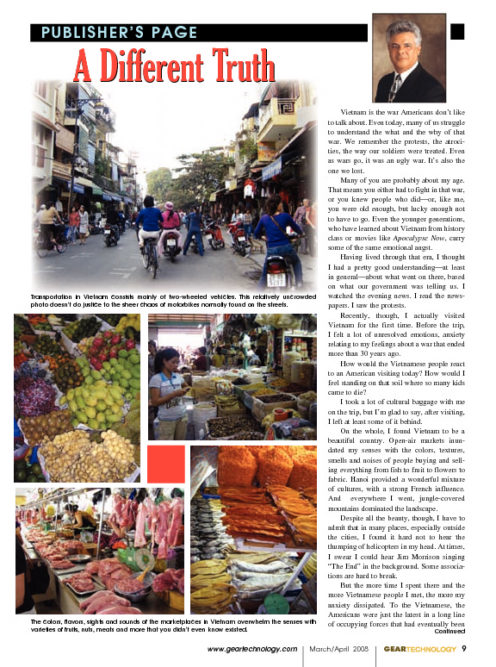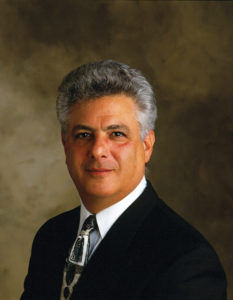A Different Truth
Vietnam is the war Americans don’t like to talk about. Even today, many of us struggle to understand the what and the why of that war. We remember the protests, the atrocities, the way our soldiers were treated. Even as wars go, it was an ugly war. It’s also the one we lost.
Many of you are probably about my age. That means you either had to fight in that war, or you knew people who did—or, like me, you were old enough, but lucky enough not to have to go. Even the younger generations, who have learned about Vietnam from history class or movies like Apocalypse Now, carry some of the same emotional angst.

Transportation in Vietnam consists mainly of two-wheeled vehicles. This relatively uncrowded photo doesn’t do justice to the sheer chaos of motorbikes normally found on the streets.
Having lived through that era, I thought I had a pretty good understanding—at least in general—about what went on there, based on what our government was telling us. I watched the evening news. I read the newspapers. I saw the protests.
Recently, though, I actually visited Vietnam for the first time. Before the trip, I felt a lot of unresolved emotions, anxiety relating to my feelings about a war that ended more than 30 years ago.
How would the Vietnamese people react to an American visiting today? How would I feel standing on that soil where so many kids came to die?
I took a lot of cultural baggage with me on the trip, but I’m glad to say, after visiting, I left at least some of it behind.

The colors, flavors, sights and sounds of the marketplaces in Vietnam overwhelm the senses with varieties of fruits, nuts, meats and more that you didn’t even know existed.
On the whole, I found Vietnam to be a beautiful country. Open-air markets inundated my senses with the colors, textures, smells and noises of people buying and selling everything from fish to fruit to flowers to fabric. Hanoi provided a wonderful mixture of cultures, with a strong French influence. And everywhere I went, jungle-covered mountains dominated the landscape.
Despite all the beauty, though, I have to admit that in many places, especially outside the cities, I found it hard not to hear the thumping of helicopters in my head. At times, I swear I could hear Jim Morrison singing “The End” in the background. Some associations are hard to break.
But the more time I spent there and the more Vietnamese people I met, the more my anxiety dissipated. To the Vietnamese, the Americans were just the latest in a long line of occupying forces that had eventually been kicked out or otherwise convinced to leave. To them, the past is in the past, and I never felt as though any of the people there held a grudge. That in itself made me feel easier about being there.

Despite the peaceful beauty of much of the country, it was hard not to imagine the thumping of helicopters when viewing scenes like this.
The Vietnamese attitude also made it much easier for me to see and understand things from their perspective.
A good example was my visit to the Cu Chi Tunnels outside Saigon. The tunnels were originally dug to fight the French. During the American war, the Viet Cong used them as a base for ambushing American and South Vietnamese troops. More than 150 miles of very narrow, heavily boobytrapped tunnels wind through the countryside.

The Cu Chi Tunnels outside Saigon were too small for most to enter. The narrow entrances and air holes disguised as termite mounds give an idea about the difficulty of the conditions the Viet Cong endured. The sharp spikes of the traps inside and outside the tunnels give an idea why the tunnels proved so difficult for enemy forces to overcome.
Prior to my trip, I knew that the tunnels were one of the devices the Viet Cong used to frustrate our military efforts there. But what struck me about the tunnels wasn’t their tactical significance in the war. It was the fact that people actually lived in these things. Babies were born and families survived down there, with very poor air quality, among the dirt and death traps.
Many of the other places I visited had some relevance to the war, but everywhere I went, I learned a different perspective. For example, the Vietnamese have their own views about what really happened at the Gulf of Tonkin and why Ho Chi Minh sought the support of the communists in the first place.
According to our tour guides, Ho Chi Minh and the Vietnamese just wanted help overthrowing their French imperial overlords. The communists provided that help. From their perspective, communism was a means to freedom, which makes America’s efforts there seem all the more ironic. Even today, under a communist government, Vietnam is one of the most entrepeneurial, fastest growing countries in Southeast Asia, with enormous amounts of private enterprise. The ideology we once feared may never have been as important in Vietnam as we imagined.

Approximately 1,600 small islands and islets make Ha Long Bay in the Gulf of Tonkin one of the most beautiful areas in Vietnam. The area is a UNESCO World Heritage site.
I’m not sure my trip helped me resolve all my feelings about the Vietnam War. Even by the end of the trip, I was still hearing helicopters. But going there and hearing the perspectives of the Vietnamese people gave me insight I didn’t have before.
Many people have drawn parallels between the Vietnam War and America’s current involvement in Iraq. I went to Vietnam thinking I knew some things about the war. I came back with the understanding that the truth isn’t as easy to understand as I thought. Now I wonder if the same is true today.
 Michael Goldstein,
Michael Goldstein,
Publisher & Editor-in-Chief






